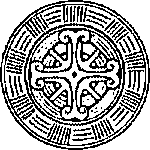
Many people with early period personas seem to think that, when choosing a religion, their options are limited to either paganism or Christianity. What most people don't realize is that early Christianity is not limited to Roman Catholicism but includes religious movements and heresies. These movements run the gamut from the devoutly reforming to the absurd. This is an attempt to persuade early period personas to incorporated these movements into the persona where it is appropriate. (Unfortunately the Inquisition wasn't' developed for several centuries, so encouraging heresy isn't' dangerous.)
A few background notes before we begin: When dealing with a largely illiterate and uneducated population, minute bits of ritual and dogma become very important, especially when one considers how central an issue salvation was to early medieval man's existence. Therefore, controversies that seem to us to be vaguely silly had far graver consequences when they involve the soul's ultimate destination.
The second point to bear in mind is that much of the information available about these movements comes to us from the Catholic Church, not the most unbiased evaluator of religious movements.
With these ideas in mind, here is a brief survey of movements:
The Gnostic movement appeared in the second century. There was little unity among the various sects, who believed that all religions led to the ultimate truth that the Gnostics alone possessed completely. Perhaps the most pervasive sect was the one founded by the Persian prophet Mani. Manicheanism, as it is called, was popular in the Mediterranean and north Africa (S. Augustine was a member of this sect before his conversion). The Manicheans believed that there were two supreme creators, one good and one evil. The creator of spirit embodied good, while the creator of matter embodied evil. Not surprisingly, Manicheans practiced contemplative asceticism. they also added a feminine component tot he traditional Trinity: a mother goddess called Charis (Grace).
The Arian heresy presented the most serious threat to the Church. Arius believed that , since Christ was begotten by the Father, Christ was slightly inferior to the Father, and hence not an equal member of the Godhead. Christ was the greatest of God's creations, but he was still not a creation. The argument becomes incredibly complex, but it is easy to see why the idea that the ultimate precursor of salvation was somewhat inferior constituted a threat to the foundations of Christianity. the Council of Nicea condemned the heresy in 325, and that would have been an end to it if Constantine's sons had not been converted to Arianism. The empire went back and forth on the issue until the emperor Theodosius I (379-395)slapped down the heresy once and (they thought) for all.
However, the Church had discounted the missionary zeal of the Arians. The Goths and Visigoths were converted to Christianity by Arian priests in roughly 337-365. subsequently, most other East German peoples also became Arians. (The west German tribes, Franks, and Saxons remained pagan for a much longer time.)
Thus, when the Ostrogoths invaded Rome, they were not pagans but heretics (which the Romans considered much worse), as were the Visigoths in Spain and southern France.
Little is known about the rituals of Arianism, but it is known that they did not celebrate the Mass. One anonymous Church father called their rites "violent and bloody, of the sort that would appeal to these people". It seems likely that this is propaganda.
The next major church controversy we'll look at is the icon controversy. As church art began to develop, many church fathers felt that the sumptuous murals and statuary violated the commandment prohibiting the making of graven images. Others felt such images to be an invaluable tool in teaching an illiterate populace. Charlemagne himself became interested in the controversy and had his scholars prepare a learned treatise that attempted to find a middle road. The controversy eventually contributed to the east-west split in the Church.
At the height of the controversy, feelings were deep and violent. There are several instances of the "iconoclasts" (icon-breakers) defacing murals and smashing statuary.
Obviously professing a belief in any of these could add color and depth to a persona (not to mention the opportunities for headed discussion and vandalism). There are many more heresies and movements, and if there is enough interest, future articles will deal with some of them.
Sources: